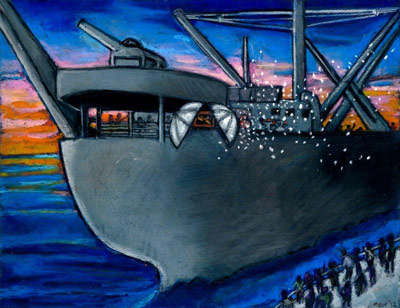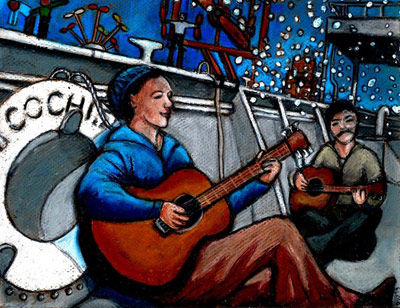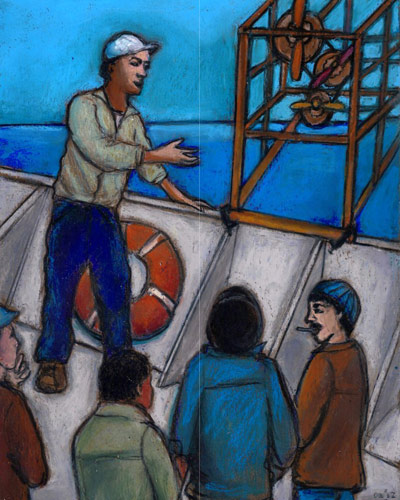Landis: The following is a tale told to me by Cisco Houston just a few short months before his death. I cannot vouch for its absolute authenticity, or that it happened exactly as written. But it did happen. Ant that is a fact that will lie in the hearts of all those who sailed on the good ship COCHISE sometime in the last year of the Second World War.
Woody Guthrie, poet laureate of the American Left, composer of songs and ballads; a “dust bowl refugee” as he so aptly described himself, was a man who truly lived his philosophy.
Few among his myriad admirers, however, are aware that Woody was also a deep-water sailor. But how else, one would ask, could he have written the most popular ballad of the Second World War, The Good Reuben James, except through a personal association with the ships and men who sailed the seas in those perilous years?
Woody Guthrie proudly called himself a union man and an anti-fascist. So he quite naturally joined the ranks of the strongest and most political of the water-front unions of that day, the National Maritime Union…
This vignette in the life of Woody Guthrie… is about an incident that reputedly took place at a rendezvous site in mid-Atlantic, sometime in the late Autumn of the last year of the war…
Woody and Cisco picked up their sailing papers from the NMU offices on 17th Street. The shipped out that same afternoon. It was a racy, balmy day, Cisco remembers, with an Indian summer breeze from upstate blowing gently through the city canyons.
Cisco called the ship the COCHISE. There was nothing special about it—ten thousand tons; a cargo of trucks, half-trucks, and jeeps. Even its sailing was simply a silent slipping away and a churning out to sea with the bow pointed north-north-east.
A giant convoy would be made up; the rendezvous point to be somewhere in mid-Atlantic with a gathering of as many as a hundred ships, and half again that number of warships to escort them to England—and to other points. Despite the fact winter was a’borning, the seas were friendly; there was calm sailing.
Woody, according to Cisco, had been below all that first day out, coming on deck only at about the hour of twilight. He had been working on something beyond his usual chores, for he brought a gadget with him, a apparatus a foot or so square and whittled, apparently from the slats of old vegetable grates. He mounted it to the stern rail with a couple of c-clamps.

It resembled a chicken-coop with interlocking sticks. A large wooden propeller was mounted on a shaft which ran through the center of it all. A rubber band connected the shaft to another, upon which was a wheel with carved, wooden gears. This touched upon another smaller geared wheel on a third shaft.
Briefly, when the large wind-driven propeller turned a second propeller on the third shaft, it went around ten times as fast. And that was it!
Except that aboard a ship on the open sea anything out of the ordinary attracts a certain attention that otherwise might not be given it. Cisco recalls—he had been the first to join Woody at the rail—that Woody, a master of amateur psychology, had looked at him steadily for a few seconds, then surreptitiously winked.
They were instantly surrounded by seamen and off duty gun-crew members: these last from the Coast Guard units attached to each ship. The men stared for long minutes, hypnotically entranced with the ready potential of the gadget and its two whirling propellers.
And then, because sailors are what they are, one of them spoke up, saying thoughtfully,
you know if you enlarged that prop for more power and then put a straight-geared shaft in a vertical slot to one side of the gearwheel with a rubber band attached to its top, well when the wheel turned—and some of its gears would be clipped for release—the shaft would be pushed down until the wheel ran out of gears. Then it would snap back up again. The gears would catch it again when the wheel came around, and so on… But the thing is that you could put a little man on top of the shaft, so that what would happen is that he’d bob up and down and wave his arms.
Everyone grinned and nodded. And Woody screwed up his eyes and asked seriously,
“how would he wave his arms?”
“Oh, well, he wouldn’t actually wave em. They’s just hang loose and sort of bounce around when he bobbed up and down.”
Another sailor who had impatiently began to pull Woody’s sleeve for attention, said suddenly and loudly,
“Well, yeah! But you could stick another vertical shaft on the other side of the smaller wheel. And it’d go up and down at a helluva rate. And you could fix it so that each time it fell back it would land on a little teeter-totter, and you know, something like a popsicle stick, only on the other and there’d be a ping-pong ball up inside the test-tube, and the ping-pong ball would fall back, and the wheel would catch the shaft again and so on… ”
“Yeah!” Woody said, pursing his lips as if pondering the merits of the last suggestion. Then he looked back to the whirling propellers and said to no one in particular,
“Yeah, you could make something like that—like the other one too, the little man.”
By this time the Second Mate had spotted the gadget from the bridge, and had come down the ladder to see just what it was that Woody “had screwed to the fucking rail.” He stayed to stare and to listen. After a few minutes of contemplation, and while other “suggestions” came flying thick and fast, he said, almost loudly,
“That God-damned thing does have some engineering possibilities, when you think about it. As a matter of fact if you extended the main shaft a little further you could add another wheel working against a horizontal geared shaft in a slot—and it would go back and forth.”
“Back and forth?” Woody squinted at him: the teacher in a nursery school. “Don’t you think you should try and get it to do something”?
‘You’re right,” the Second replied, pounding a fat fist into an equally fat palm. And at that very instant, according to Cisco, his eyes too became slightly glazed with the far-away look of the “creator.”
Woody stared out to sea again. He had a strange way of dominating; especially his own scene. He said bluntly,
“There’s a lot of crate pieces down there. Just make whatever you make strong, so it won’t fall apart.”
The sudden rush to below was phenomenal.
And so, as Cisco Houston tells the story, the WIND MACHINE was born, survived, and began to grow on the stern rail of the Liberty Ship, COCHISE.
By the afternoon of the second day many propellers, some large, some small, had been added to the Wind Machine—as well as two little men in patched denim who bobbed up and down and “waved” their arms: something that resembled a Rhode-Island-Red hen with feathers that did the same thing, a blue ping pong ball that bounced up and down inside a corked test-tube, and was thrumped over and over again by a horizontal shaft, only to bounced back within its slot after having hit a spring placed in the far end of same.
At about seventeen hours (twilight) of the same day, there was a natural gravitation toward the afterdeck and the stern rail. The Chief Steward, who was busily at work on a gadget of his own, sent up a couple of tureens of coffee and a large platter of peanut-butter and jelly sandwiches.

They gathered, ostensibly, to hear Woody and Cisco play and sing “those old favorites you’ve learned to know and love”—Philadelphia lawyer. Talking Union. Viva le Quince Brigada, Old Dog Blue, and Diamond Jim. But strange and intangible ties now existed between those who had taken the Wind Machine for their own. It was as if they needed to be near it as proof-positive of affinity with the “creation”. The object of their affections, that oddly graceful bundle of fragile bits of wood and string now occupied a cubic yard of space.
And the work went on—all night by the different watches, and all the next day by those who had free time and the inclination—and almost everyone had that. And anyone who went on deck for whatever reason would inevitably join the vigil of the devotees of the Wind Machine.
They came to stay and to worship at the growing mass of propellers, rubber-bands, string, popsicle sticks and orange-crate effigies. By the third day’s eve the Wind Machine possessed a melodious bird-call produced by a wind funnel—it only worked in the following breeze; a chicken-chuckle, made with a bamboo pipe and an intricate pattern of baffles, and an assortment of penny-whistles. Houston confesses he never knew the principles of their operation.
And then the ship’s Captain added his own, most singular touch. It was a simple wind-harp made of two tautly strung gut strings from his violin; it gave forth with a soft and sweetly sad thruuuuuuuummmm….
On the following day the First Mate melded his contribution to the whole. A simple propeller whose rubber band turned a second shaft which had four small rubber paddles on it. These paddles beat upon the exposed rump of a bent over and intricately carved William Randolph Hearst, whom the First Mate dearly hated.
The following morning also saw, along with new additions to Woody’s brainchild, a heavy breeze to starboard. It was not sufficiently gusty to threaten the Wind Machine. But the warning was implicit. The remainder of the day was spent in devising some form of protection for it: this by all those off duty. The solution came in the form of a huge ball-like contraption whose principles resembled those of Buckminster Fuller’s geodesic dome. It was constructed in two halves, of wire and canvas. Cisco describes it as being about eight feet in diameter, and hinged at the top. And, since the Wind Machine was then elevated to some three feet above the rail by a series of tightly clamped two-by-fours, the “ball” could open its maw and devour it completely—with no single part of the Wind Machine touching its inner surface.
The wind, except for the usual breeze, died at twilight. And those who could, came on deck to listen to Woody and Cisco; to drink coffee and eat peanut-butter and jelly sandwiches, and be with the Wind machine. In the midst of an ocean fraught with perils, some said that it gave them a feeling of security. The sounds it made, according to Cisco, were barely audible beyond a hundred feet.
But within that magic periphery there was a continuous whirring and chuckling, a tootling, a beeping and a warbling and whistling. And above it all, but oh, so faint, was the steady thrruuuummmmmm of the wind-harp.
And then of course, before darkness closed in, there were the things to watch: the two little men who waved their arms; the Rhode Island Red who flapped her wings, the ping-pong ball and the marble; William Randolph Hearst and two new creations of a certain pornographic bent in which various figures did various things—and all within a myriad of whirling propellers. The porno, Cisco tells us, was contributed by the gun crew.
And all of it, as Woody had insisted, was built strong.
Woody, the Chief Steward and a seaman nicknamed “potatoes”—ashore he was the biggest drunk in the red-Hook district—had been appointed as the ones to decide on the acceptance or rejection of new ideas. On the following day, however, with the COCHISE having reached its rendezvous point, and with the addition of all but one creation, the Wind Machine had reached full capacity. As the Captain pointed out, for it to grow would require a bigger protective ball, and he doubted if they had sufficient material.

The last addition was a bubble blower. A series of brass rings on a string was dipped into soapy water, raised and dipped again, etc. When raised, the action of the wind on the rings was as to surround the Wind Machine with a fairy-land of iridescent bursts of watery color.
Woody then suggested to the ship’s union committee that the Wind Machine be exposed to the elements only during the few hours before and after twilight—when coffee and such could be served, guitars could play, and all those off duty could gather. This was agreed upon.
And in part, Cisco relates, it was agreed upon for the simple reason that now they were in convoy, they did not want to share the Wind Machine with anyone. A first evidence of this odd phenomenon was that when the COCHISE had put out its sea-anchor, and when a “captain’s gig” from a tanker a quarter of a mile to port had circled their stern to have a look at the big ball hooked to the rail, the men on vigil had instantly and telepathically “dummied up.”
“What ye got there?” someone yelled from the gig. “Radar!” The gravel-voiced answer came from Potatoes, while the others who lined the rail simply glared in a hostile fashion. That night their singing voices were somewhat muted, as if fearful of attracting attention.
In the morning, with the Wind Machine safely buttoned up, a tin can (destroyer) arrived to pick the Captain, the First Mate and Chief Engineer for briefing. There were already as many as forty ships gathered. On the far horizon other destroyers and corvettes could be seen weaving anti-submarine patterns around the great pod of fat-bellied freighters stuffed with goodies for the Allied Armies.
The Captain returned, smiling grimly. Two corvettes accompanied the destroyer. They lingered to roll gently in the swells and to stare at the bubble housing the Wind Machine. Then they flanked the COCHISE while it upped-anchor and got under way—but only for a few miles, to the center of the convoy.
Woody, Grinning from ear to ear, explained this move to Cisco; he got it from the First Mate who had accompanied the Captain. Scuttlebutt had evidently gone wild within the convoy throughout the night. The result was that the Commander of the destroyer escort had decided that the bubble-protected Wind Machine was some sort of secret weapon. And he was duty-bound to see to it that the COCHISE had extra protection.
According to the First Mate, the conversation preceding the event had been rather weird. The briefing was over; the other Captains had left for their respective ships on gigs and whatever…
The Escort Commander said, conspiratorially, to the COCHISE’s Captain: “Now about that peculiar looking object you have mounted to your stern rail? I didn’t want to speak to you in front of the others—but is there anything I should know about? One of your men said it was radar equipment.”
The Commander was a lean, bright-eyed, middle-aged crew cut type with a median-low I.Q. and a jolly cloak-and-dagger mentality derived of too many mystery stories. He was, according to the First Mate, a man with a penchant for second-guessing, and then acting instantly in the firm belief of his own omnipotence.
The COCHISE’s Captain, to the contrary, was an old Swede who simply did his job as best he could, refusing to be a victim of the nonsense that went on around him. His contribution, the Aeolian wind harp, should speak sufficiently for his knowledge and his character. he simply puffed his pipe, grunted, stared blankly at the Commander and then said perfunctorily, “It’s just a gadget. forget it.”
How the Escort Commander managed to see a cryptic syntax of mystery and subterfuge in this so simple statement is beyond belief, but he did… He winked, oh, so wisely, held up his hand and said, “Never mind, I know.” Then he suggested, and again in confidential tones, that the COCHISE would perhaps be safer in the center of the convoy.
The Captain just looked at him and shook his head and retired to the Jacobs ladder and the gig that would return him to the COCHISE, and that was that.
Within two days the convoy was completed and the last leg of the run to Liverpool, Southampton, and Glasgow was underway.
Coffee and sandwiches continued to be served on the afterdeck of the COCHISE; songs were sung, meetings held. And, at the first sign of gathering dusk, when visibility would be limited to but a few hundred feet, the Wind Machine would be allowed free reign to spin its hypnotic web of rainbows.
Prior to getting under way, many a Captain’s gig had circled the COCHISE; for apparently one had gotten close enough on the first night to hear the muted whistling, warbling and thrumming and to see perhaps, a soap-bubble or two float lazily across its bow. And too, for some reason known only to seamen, the word had quickly spread that the convoy was not “centered” on the COCHISE, because its “secret weapon” was actually something that could control the wind, and that therefore the convoy would be safe from all storms.
Woody psyched out this conclusion as a wishful thinking common to every sailor’s dread of nature’s potential holocaust. he also thought it interesting that they had designated the “weapon” as having something to do with the wind.